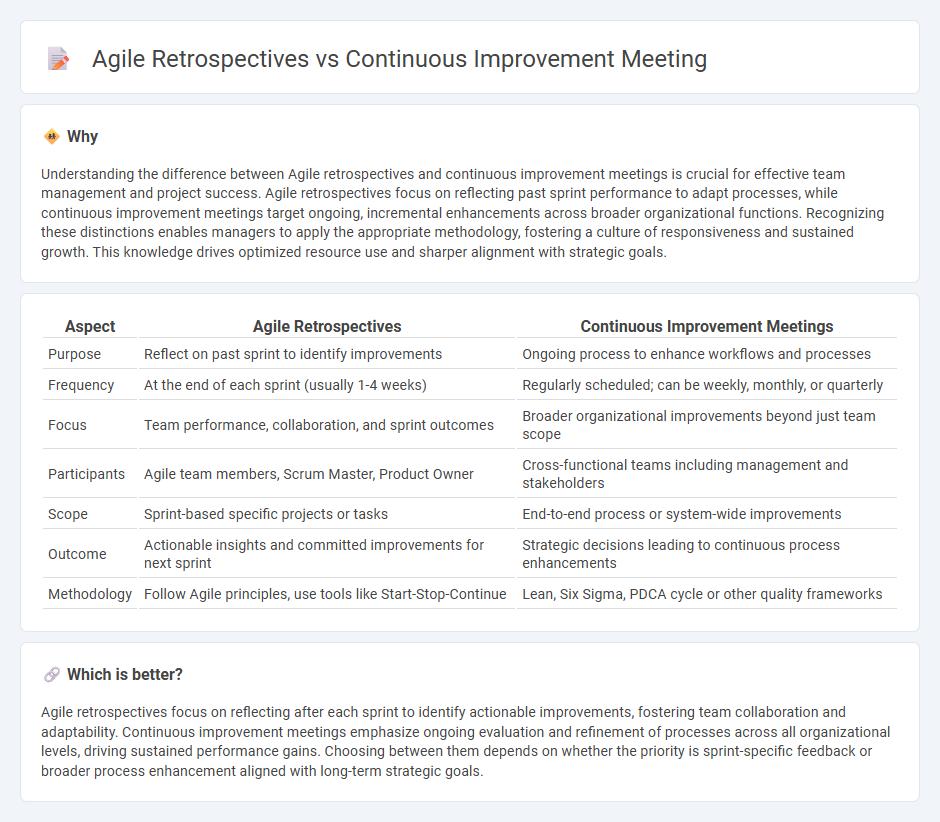
Agile retrospectives focus on iterative team reflection after each sprint to identify successes and areas for enhancement, promoting adaptive project management. Continuous improvement meetings emphasize ongoing process optimization across all organizational levels, targeting long-term efficiency and quality gains. Explore how these approaches can transform your management practices for sustained growth.
Why it is important
Understanding the difference between Agile retrospectives and continuous improvement meetings is crucial for effective team management and project success. Agile retrospectives focus on reflecting past sprint performance to adapt processes, while continuous improvement meetings target ongoing, incremental enhancements across broader organizational functions. Recognizing these distinctions enables managers to apply the appropriate methodology, fostering a culture of responsiveness and sustained growth. This knowledge drives optimized resource use and sharper alignment with strategic goals.
Comparison Table
| Aspect | Agile Retrospectives | Continuous Improvement Meetings |
|---|---|---|
| Purpose | Reflect on past sprint to identify improvements | Ongoing process to enhance workflows and processes |
| Frequency | At the end of each sprint (usually 1-4 weeks) | Regularly scheduled; can be weekly, monthly, or quarterly |
| Focus | Team performance, collaboration, and sprint outcomes | Broader organizational improvements beyond just team scope |
| Participants | Agile team members, Scrum Master, Product Owner | Cross-functional teams including management and stakeholders |
| Scope | Sprint-based specific projects or tasks | End-to-end process or system-wide improvements |
| Outcome | Actionable insights and committed improvements for next sprint | Strategic decisions leading to continuous process enhancements |
| Methodology | Follow Agile principles, use tools like Start-Stop-Continue | Lean, Six Sigma, PDCA cycle or other quality frameworks |
Which is better?
Agile retrospectives focus on reflecting after each sprint to identify actionable improvements, fostering team collaboration and adaptability. Continuous improvement meetings emphasize ongoing evaluation and refinement of processes across all organizational levels, driving sustained performance gains. Choosing between them depends on whether the priority is sprint-specific feedback or broader process enhancement aligned with long-term strategic goals.
Connection
Agile retrospectives and continuous improvement meetings both focus on enhancing team performance through iterative reflection and feedback. Agile retrospectives systematically analyze completed sprints to identify actionable improvements, while continuous improvement meetings regularly assess ongoing processes to drive incremental enhancements. Together, they create a feedback loop that fosters adaptive project management and sustained organizational growth.
Key Terms
**Continuous improvement meeting:**
Continuous improvement meetings center on systematically identifying inefficiencies and implementing targeted solutions to enhance processes, often guided by Lean Six Sigma principles. These meetings emphasize data-driven analysis and cross-functional collaboration to achieve measurable performance improvements over time. Explore how continuous improvement meetings can transform your workflow and boost operational excellence.
Kaizen
Continuous improvement meetings emphasize structured, ongoing enhancement processes rooted in the Kaizen philosophy, targeting incremental and consistent operational gains. Agile retrospectives serve as time-boxed sessions within sprint cycles to reflect on team performance and adapt workflows, promoting flexibility and responsiveness. Explore the distinctions between these approaches to optimize your team's efficiency and innovation strategies.
PDCA (Plan-Do-Check-Act)
Continuous improvement meetings center on the PDCA (Plan-Do-Check-Act) cycle to systematically identify and resolve problems, ensuring ongoing process enhancement. Agile retrospectives emphasize team reflection and adaptation after each sprint, aligning closely with the PDCA phases to foster iterative growth and efficiency. Explore how integrating PDCA into both frameworks can elevate your organization's continuous improvement efforts.
 dowidth.com
dowidth.com